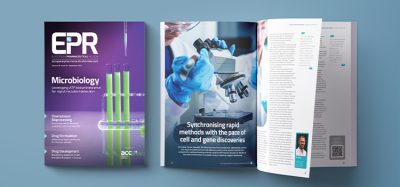Cost, knowledge and convenience: facing the facts
There can be no doubt that the FDA’s initiative on Process Analytical Technologies (PAT) has had an enormous impact on the pharmaceutical industries. However, the emergence of ’born again‘ PAT devotees in pharma companies has caused mild amusement in other industries where on-line analysis has been an integral part of process monitoring and control for a long time.
There can be no doubt that the FDA’s initiative on Process Analytical Technologies (PAT) has had an enormous impact on the pharmaceutical industries. However, the emergence of ’born again‘ PAT devotees in pharma companies has caused mild amusement in other industries where on-line analysis has been an integral part of process monitoring and control for a long time.
There can be no doubt that the FDA’s initiative on Process Analytical Technologies (PAT) has had an enormous impact on the pharmaceutical industries. However, the emergence of ’born again‘ PAT devotees in pharma companies has caused mild amusement in other industries where on-line analysis has been an integral part of process monitoring and control for a long time.
In the petrochemicals and food sectors in particular, a number of well known companies have used a variety of process analysis techniques for many years to ensure safe and environmentally friendly operation of plants and achieve world class manufacturing efficiency that has helped them complete successfully in world markets. The potential benefits of PAT to the pharmaceutical industry are substantial. Although the R&D costs associated with pharmaceutical product evolution are high, they are almost matched by manufacturing costs, which could be reduced significantly through judicious use of PAT. In continuous and batch chemicals manufacturing, the potential benefits of improved manufacturing performance can be of the order of 5 and 10 per cent, respectively, as a very approximate estimate. In pharma biotechnology processes, improvements could yield a much higher percentage of benefits, worth billions of dollars worldwide.
Making use of PAT across the board
PAT will certainly prove to be a very important development for pharma companies – and the good news is that the technology required to implement PAT exists now. Companies can buy a raft of spectroscopic, chromatographic, imaging, electrochemical and other techniques for on-line, in-line and even non-invasive analysis of plants and processes. There are plenty of good software packages for data analysis, data visualisation, on-line optimisation, performance monitoring, real-time control etc. Many of these techniques and procedures can be used to good effect not only in manufacturing, but also throughout the product chain from discovery, through development, into pilot scale and then full scale production. But the question is “how many companies in the chemicals and pharmaceuticals sectors make use of existing technology in this way?”. Through my involvement in the Centre for Process Analysis and Control Technology (CPACT), I know many of the people responsible for PAT and on-line control activities in a variety of organisations; I meet them at conferences, such as IFPAC and APACT (Advances in Process Analytics and Control Technologies). They come mainly from large blue chip multi-national companies. Very rarely do I hear of SME companies in the high technology industries using PAT. The stark reality is that the potential benefits of PAT, process monitoring and on-line process optimisation and control are not accessible to the very many companies that play an important role in the pharmaceutical, chemicals and healthcare industries, indeed the whole manufacturing and processing sectors in general.
A question of cost and knowledge
Why is this? There are several reasons: high cost, low confidence, poor knowledge and lack of convenience. The simple fact is that most on-line process analysers cost a lot of money not only to purchase, but also to implement and support. Even so, the financial benefits of improved process analysis and control can be large enough that the pay-back time may be well under a year. A cost-benefit analysis can provide this information. However, plant managers are often unwilling to take a chance, they are paid not to! This is a particular issue if a company has no prior experience of successful deployment of on-line process analysis and control. The situation is not helped if no-one in the company is really sure what various on-line techniques and procedures can do, nor has the time to find out. The lack of knowledge regarding the techniques and procedures that exist, compounded by a relatively large entry cost to the application of process analysis and control means that it is very hard for SME companies, in particular, to make use of current technologies. In contrast, the larger companies in the pharmaceuticals and chemicals industries have started to make progress in the implementation of PAT over recent years. As a consequence, the gap in PAT capabilities between the SME producers and large companies is increasing.
Addressing the challenges
To deal with this problem and make the advantages of improved process analysis and control accessible to all, the issues of cost, knowledge and convenience need to be addressed. There is no easy fix, but a start must be made somewhere.
A radical change is required in the design of process analysers. Many of the best and most widely used on-line spectroscopic instruments are designed to be flexible, multi-task analysers that cover a wide range of wavelengths or wavenumbers: they are built along traditional lines, are relatively large and cost more than a luxury high performance car. But process analysers are frequently used for specific tasks, often in locations where there is limited space to add anything to the infrastructure, and many similar units could be required on multiple plants and sites. With developments in MEMs and silicon chip based devices and the advent of reliable micro-fluidics and micro-optical machining, advances are now being made in the miniaturisation of spectroscopic and chromatographic analysers. More needs to be done in this area because there are real benefits to be gained by reducing the size of analysers: lower cost, lower power requirements and the possibility of wireless operation. Of course, compromises will have to be made: analysers will be more application specific rather than general multi-purpose instruments. For example, instead of buying a near-infrared spectrometer, you will buy a ‘fermentation’ analyser that may have a number of micro-modules, each configured for a different measurement and each with on-board chemometric algorithms for signal processing and calibration. The measurement performance will need to be at least as good as that of current instruments, although perhaps over a narrower spectral range. The smaller size and wireless operation will make it easier to locate analysers within plant/process infrastructure and the lower cost will make purchase of such devices more attractive and seem less of a financial risk.
What about vendor company interests? Selling lower cost analysers will not seem like good business practice to them. It is clear that there will need to be a significant change in business philosophy in this area. Certain companies will make the component parts (as happens now) and other companies will package them together to sell instruments that satisfy a market need. Not only will these vendor companies make money by selling more analysers, they will also help make the business case, perhaps help commission the analyser and then support the device during its lifetime. In return, the provider of the technical solution will receive a fraction of the financial benefits gained by the end user through successful use of the analysers. Accordingly, only those vendor companies who provide robust and reliable technical solutions will survive.
Knowledge is power
If cost is one barrier to many companies deploying process analysis and control technologies, lack of knowledge and training is another. If this problem could be addressed, not only would there be an improvement in the awareness of what different instruments and software packages can do, but there would also be a general increase in the level of confidence of scientists and engineers to embrace PAT, evaluate the benefits through cost-benefit analysis and hold probing discussions with vendors! But surely there are lots of PAT conferences and courses that provide the training and information required? There are two problems here: the costs of these courses/workshops are too high and the numbers of participants from non-blue chip companies too few. Even the value-for-money training courses offered by CPACT only scratch the surface of the problem. We need to find some way to educate many more people in the basics of process analysis and control, at a cost that is not prohibitive. This needs to be done with some form of Government support or incentive, on a regional basis, as a matter of urgency. The basic level of knowledge in companies needs to be raised so that a significantly greater number and range of organisations can engage in PAT and on-line process control in general. But why should governments care? There are three reasons: jobs, economic sustainability and environmental benefit. All three can benefit from judicious use of process analysis and control. Perhaps we need to train ’trainers‘ who then educate their colleagues in-house in the topics of greatest relevance to the company’s needs. Who will supply the training? There are now a lot of individuals from industry and academia with experience in process analysis and control. It should be possible to harness the skills and experience of such individuals to good effect. In the USA, CPACT’s sister organisations CPAC and MCEC are collaborating with other organisations to train regulators and others on the technologies relevant to the FDA’s PAT initiative. This approach should be extended and awareness training at the very least made available to all who need to improve their knowledge, whether they come from a large or small company.
On the research front, increasing numbers of scientists and engineers are developing the technologies required to facilitate wider use of PAT. This includes improvements in chip-based devices that will hopefully lead to a greater range of reliable and useful miniature analysers. Every year, specialist companies emerge in the micro-sensor field, often as spin- out companies from academia. However, more needs to be done in this area, as current miniaturised instruments are often limited in range and performance. Industry and academia are collaborating through multi-disciplinary organisations such as CPACT, CPAC and MCEC, to help direct primary fundamental academic research, increase implementation of technology in industry and provide training. Some of this effort, such as the NeSSI project, is addressing the need for convenience when configuring sampling and multi-faceted monitoring modules for on-line analysis. We are also starting to see joined-up thinking throughout the supply chain, with the realisation that the measurement and control methodologies devised for conventional manufacturing plants are also useful in high throughput experimentation and with newer, flexible manufacturing systems.
What needs to happen?
But it is no good tampering at the edges. A large step-change is required in industry attitudes and Government actions. The uptake of on-line process analysis and control cannot be left to reach its own level. Large and small companies in the high technology industries make important contributions to the economy of many countries. The benefits that advances in technology and training can bring need to be better enunciated to Ministers and CEOs. Funding agencies should encourage multi-disciplinary research in this field, with the clear intention of supporting manufacturing and processing industries. It will only be through adventurous policy developments at all levels that real-time process analysis and control becomes ubiquitous and that PAT is accessible to all.
The opinions expressed in this article are those of the Author and do not necessarily reflect the views of the organisations mentioned.







